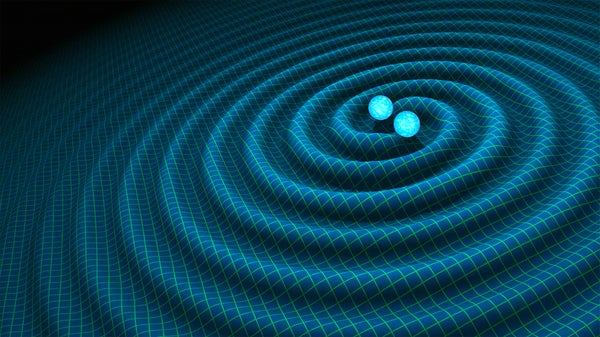As many expected, the Nobel Prize in Physics this year will go to three scientists who led the 50-year quest to detect gravitational waves. Rainer Weiss, Barry Barish and Kip Thorne will share the prize for their work on the Laser Interferometer Gravitational Wave Observatory (LIGO), which in 2016 announced it had detected ripples in spacetime for the first time.
“This year’s prize is about a discovery that shook the world,” Göran Hansson, secretary general of the Royal Swedish Academy of Sciences, said this morning at the Nobel Prize press conference announcing the award. He was speaking both figuratively and literally about a scientific achievement that has garnered headlines worldwide, originating in cosmic cataclysms whose repercussions we feel on Earth billions of light-years from where they started.
“It’s really wonderful,” Weiss said this morning by phone at the Nobel Prize press conference. “I view this more as a thing that recognizes the work of about 1,000 people.” LIGO involves scientists from about 90 institutions on five continents. The experiment has now reported four separate observations of gravitational waves. The latest, announced less than a week ago, was made jointly with LIGO’s European counterpart, the Virgo experiment. “Thinking about this, trying to make a detection in the early days, sometimes trying and failing,” Weiss recalled. “It’s very, very exciting that it worked out in the end.”
On supporting science journalism
If you're enjoying this article, consider supporting our award-winning journalism by subscribing. By purchasing a subscription you are helping to ensure the future of impactful stories about the discoveries and ideas shaping our world today.
Gravitational waves, first predicted more than 100 years ago by Albert Einstein’s general theory of relativity, are vibrations in the fabric of the universe created when extremely massive objects bend spacetime around them. The signals LIGO has seen so far have each come from collisions between two black holes—cosmic fender benders whose violence is beyond imagination.
“This is a truly remarkable achievement which crowns almost 50 years of experimental efforts,” said Nils Mårtensson, chairman of the Nobel Committee for Physics. Half of the 9 million Swedish krona ($1.1 million) prize goes to Weiss, a physicist at Massachusetts Institute of Technology who spearheaded the effort to design and build LIGO in its earliest days. Thorne, a physicist at California Institute of Technology, is a co-founder of the experiment who led the theoretical work to predict what signals from black hole collisions would look like. Barish, also a physicist at Caltech, is responsible for helping the experiment achieve the extreme precision required to detect gravitational waves.
“Today is a special day for our whole community,” says Georgia Institute of Technology physicist Laura Cadonati, deputy spokesperson for the LIGO Scientific Collaboration. “Hundreds of scientists across the world were following the Nobel feed and messages were flying in e-mail and social media. Many of us were a little tearful, and I suspect celebrations will be held across the world today, for Rai, Kip and Barry but also for the LIGO Scientific Collaboration, our friends and colleagues in VIRGO, and the future of gravitational wave astrophysics. It is a happy day indeed.”
LIGO is made of two laser interferometer detectors—one in Washington State and the other in Louisiana, to observe the distortions in space created when a gravitational wave comes along. Shaped like giant L's, the detectors use mirrors to bounce laser light back and forth along their perpendicular four-kilometer-long legs. Incredibly precise atomic clocks detect differences in the amount of time it takes the light to traverse the legs. If a wave has passed through, expanding and contracting Earth around it, the legs will no longer be exactly equal length, and one of the laser beams will arrive a fraction of a second later than the other.
The experiment began in the 1960s but took decades to achieve the sensitivity it needed to measure the tiny time lag the laser beams display due to gravitational waves. LIGO scientists made the first confirmed signal in September 2015 and announced the finding the following February. Plans for similar detectors are in the works now in Japan, India and elsewhere.
“This award is important, as it helps mark the beginning of a new era in physics and astronomy, an era in which we have a new tool to probe the far reaches of the cosmos—using gravitational waves,” says Robert Caldwell, a professor of physics and astronomy at Dartmouth College. “In fact, there is a 'dark world' out there of black holes and other exotic objects, which we can access only through gravitational waves. This is truly exciting—like gaining a new sense.”
